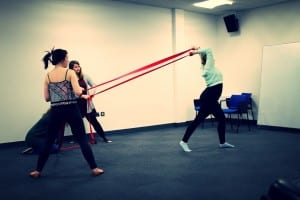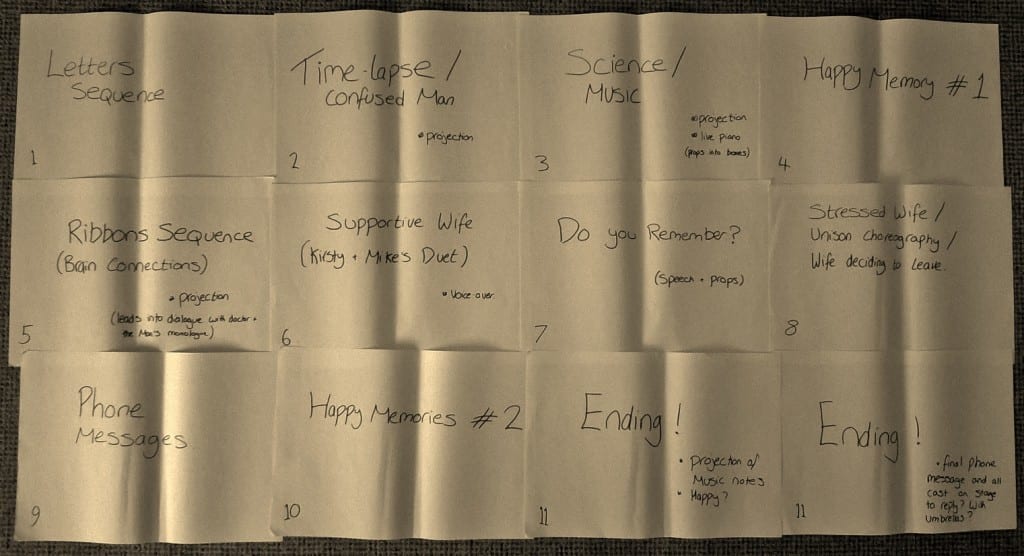As the piece has developed, I have come to realise that a large amount of the material has been heavily focused on either the emotional impact encephalitis can have on a relationship or the science behind the illness. The emotional and scientific elements are always merged throughout the piece, for example, the ‘Ribbons Sequence’.
(Alice Dale, 2015)
This visually represents the connections in the brain and how, when suffering from encephalitis, these connections don’t match up. During the sequence, The Man and one of the female performers have a duologue, expressing The Man’s confusion about entries in his dairy which he does not remember writing. This shows his emotional state as a result of the malfunctioning brain.
Much of the show currently consists of this format and although it is essential that the style remains similar throughout, I have felt an urge to interject scenes with a different mood to change the dynamics and pace. This resulted in creating a couple of ‘happy memory’ scenes. These are mainly made up of movement sequences using small gestures, props and subtle moments of eye contact which express the mundane lives this couple had before the illness struck. A piece that influenced me for these sections of the piece is Theatre Ad Infinitum’s Translunar Paradise (2011).
What I found captivating about this particular piece was the subtlety in the movements and the connection between the performers. This was something I really wanted to emphasise in our happy memory sequences. It has been more difficult to have these subtle moments in our piece due to the size of our cast and the fact that all of the female performers are constantly overlapping as the character of The Wife, To get around this, I have inserted moments where the couple embrace or are alone on stage which furthermore ensures that the audience understands who is portraying The Wife in these scenes.
In general, I have seen myself as an editor of the performance; I ask the performers to create a scene, movement sequence or write text, all of which are based on a scenario or text that I bring in to the session. I have then gone away and worked on the movement with Rachel, selecting elements that fit together well as well as adding in our own input. Similarly with any text the cast have written in rehearsals, I have then taken it away and put it into context, re-worded and organised it all to flow with the rest of the scene. However, there have been occasions where Rachel and I have had a clear idea of what we wanted for a scene, for example, the scene where The Wife decides to leave The Man. This was a choreographed sequence which we rehearsed and taut to the rest of the group.
After completing these scenes, I have been in a position to start piecing the show together, deciding where scenes should go, what transitions need creating and essentially the flow of the entire piece.
(Michael Woodhall, 2015)
(Michael Woodhall, 2015)
As you can see from these two photos, the piece was constantly changing. Scenes such as the ‘Office Sequence’ did not fit into our narrative and was eventually cut from the show and the order of scenes has also been altered throughout the rehearsal process, even after we began running the entire show. Even at this stage, I am unsure of how the show will end which is both exciting and frightening at the same time!
Works Cited
Theatre Ad Infinitum, (2015) Theatre Ad Infinitum. [online] Available from http://www.theatreadinfinitum.co.uk/ [Accessed 25 May 2015].



Leave a comment